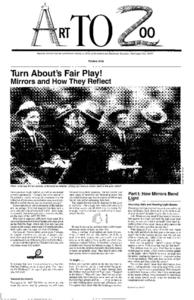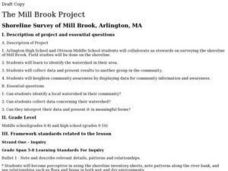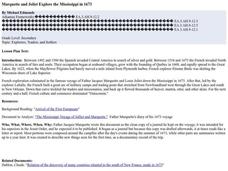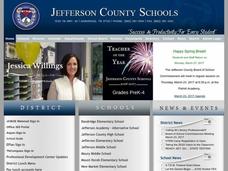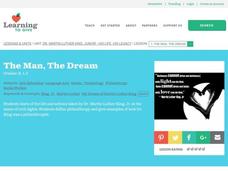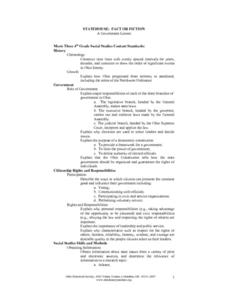Learning to Give
Africa - The Great Southland
Applying the five themes of geography, preteen explorers develop a visual aid for younger learners in celebration African American History Month. They investigate the political, geographic, economic, and social aspects of the continent...
Curated OER
Congruent Triangles
Young scholars explore the concept of congruent triangles. In this congruent triangles lesson plan, students use Cabri Jr. to construct two congruent triangles using circles. Young scholars determine if the two triangles are...
Curated OER
Summarizing Worksheet
In this summarizing skills worksheet, students answer ten multiple choice questions based on the conceptual framework for writing a summary.
Curated OER
Outline It!
Fourth graders investigate how outlining can aid in comprehending text. In this reading comprehension lesson, 4th graders outline an article they read in groups of two. Students take turns reading the article, identifying the main idea,...
Curated OER
A Rock’n Earth
Seventh graders identify the three types of rocks. For this earth science lesson, 7th graders model the rock cycle using crayon shaving. They explain how rocks change as they go through the cycle.
Curated OER
Mirrors and How They Reflect
Students experiment with mirrors. In this Mirrors and How They reflect lesson plan, students read how mirrors reflect light. Then students perform over ten experiments and record their conclusions about mirrors and reflection. Students...
Curated OER
Sound Portraits
Students observe a variety of sounds which can be heard within their schoolyard habitat by sitting quietly by themselves for five minutes, listening, and then recording the sounds around them by drawing them.
Curated OER
The Study of Urban and Suburban Environments within the Mystic River Watershed
High school learners examine their own water-based environments, within the Mystic Watershed. As the learners engage in inquiry-based, hands-on projects, critical thinking skills and problem-solving, the project will lead them to cross...
Curated OER
Reading Chemical Formulas
Students interpret basic chemical formulas. When class begins, students interpret a "chemical formula" for fruit salad. After they interpret the recipe, students use the same strategies to identify chemical formulas. They evaluate the...
Curated OER
Marquette and Joliet Explore the Mississippi in 1673
Young scholars locate and name the St. Lawrence River, the five Great Lakes, and the Mississippi River on a modern map. They find Quebec, Michilimackinac, Wisconsin, and Chicago on that map. They find the same places on a 1681 map.
Curated OER
Punctuation Review/Tic-tac-toe
Sixth graders play a tic-tac-toe game in pairs. In this language arts lesson, one student uses an X to show the correct sentences, while the other student uses an O to show incorrect sentences. Students use a T-chart to record the...
Curated OER
Science Giants
Fifth graders research about the work and accomplishments of their chosen scientist. In this life science lesson, 5th graders explore how to become one. They prepare a presentation and share it with the class.
Curated OER
Day in the Life of a Homeless Person
Students examine a day from the point of view of a homeless person. They listen to and discuss two stories, identify ways to help homeless people, watch a Reading Rainbow video, and write an essay.
Curated OER
Junk Sort
Students analyze objects by one or more attributes. In this sorting lesson, students use manipulatives and string or yarn to create a sorting game. Students read books and items from the classroom to sort.
Curated OER
GUITARS AS SCULPTURE
Middle schoolers discuss guitars, pointing out different parts of the guitar, compare/contrast guitars from different times, imagine they are designers hired to build a new age guitar, create many preliminary sketches, choose one, and...
Curated OER
Skeletal System
Seventh graders identify and label twenty-five bones of the skeletal system. In small groups they glue various types of dried pasta to a large human body outline. They attach the pasta to the outline and label the pasta bones.
Curated OER
Searching For Letters, Words, and Sentences
This simple lesson is designed for K - 1 students. They are introduced to individual letters, words, and sentences. A game is played where they try to collect one example of each. For practice, students complete a worksheet which is...
Curated OER
The Man, The Dream
Students discuss how one person's life can affect a community . In this Martin Luther King Jr. lesson, students read about Dr. King's life and contributions. They formulate ideas about how they can meet the needs of their own community.
Curated OER
Is This Really Okay for Me? A Public Health Statistical Analysis
Future public health consultants are asked in a letter to help determine if a fictitious drug is causing birth defects in a population. They perform a simulation using beans and probability calculations to come to a conclusion. Note that...
Curated OER
Deadly Desires
A activity on STD's captures learners with shocking statistics. Small groups create informational brochures on specific STD's, which they will present to the class. The links for research are overall excellent, but should be previewed...
Curated OER
Heart Smart in a Heart Beat
As an introductory activity, young statisticians measure their heart rate at rest and after exercise and compute the mean and median, and create a box & whisker plot. This is followed by watching a video (that no longer seems...
Curated OER
Conversions Using English Units
Students explore the concept of English units. In this English units lesson, students convert from one English unit to another English unit. Students estimate the size and weight of objects using English units.
Curated OER
Statehouse: Fact or Fiction
Fourth graders determine whether or not statements about the Ohio statehouse are true or false. They examine the stories behind the myths about it. including one about the ghost of Abraham Lincoln.
Curated OER
Projecting the Image -- What Can One Person Do?
Students research individuals who have received the Nobel Peace Prize. They identify the importance of their actions for the common good. They make note of their background, motivations and values.





